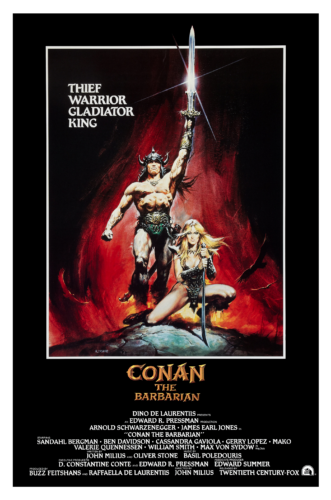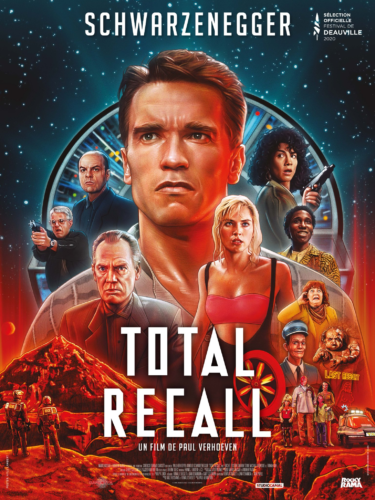 Conan the Barbarian (1982) – Continuing my occasional series of “movies I haven’t seen in over thirty years, and then probably only saw it on TV”…
Conan the Barbarian (1982) – Continuing my occasional series of “movies I haven’t seen in over thirty years, and then probably only saw it on TV”…
This movie has two big problems, and I’m sorry if you disagree, but you’re wrong:
1) Despite the opening credit that says this is based on the character created by Robert E. Howard, this character named Conan really doesn’t resemble Howard’s Conan at all. The “real” Conan was a wild semi-savage, naturally intelligent and clever; he left his Cimmerian homeland because of wanderlust and curiosity about “civilization,” and his adventures feature him exploiting the civilized countries of the Hyborian Age, marveling at the luxuries of civilization but not wanting to accept the softening soul-rot that comes with the taming of men to live in that world.
Compare that to the Conan of this movie: He’s one of the few child survivors of a slaving attack on his village (because Cimmerians make good slaves?), he gains all of his muscles pushing the crank on a grain mill for a decade, he’s then groomed as a pit fighter, and then for some reason his owner sets him free and he wanders off. His entire life has happened to him, and he’s a stupid, clumsy side of beef, more like Sergio Aragonés’ spoof character Groo the Wanderer than Howard’s canny barbarian.
Say what you will about the 2011 attempt to reboot the Conan movie franchise — and that’s a movie deserving of quite a lot of criticism as well — but at least that version of Conan was a lot closer to the character from the original stories. (The one incident in this movie drawn clearly from the original stories, with Conan condemned to death by crucifixion, is robbed of its original power by having him rescued passively when pretty much dead — again, it’s stuff that happens to him. In the original story, Conan is only semi-rescued by a hardened robber, who watches Conan pull out his own crucifixion spikes to prove his worthiness to survive.)
2) Even once you concede that this is a movie set in Howard’s Hyborian Age about some unrelated character named Conan… it’s still a poor story. Things happen for no real reason, like Conan’s sudden freedom from being a pit fighter slave, or his one-night stand with the shape-changing witch, or his encounter with the wizard who becomes his chronicler, or Thulsa Doom’s random shape-changing for no reason in one scene… Conan’s supposed “romance” with Sandahl Bergman is one of the most chemistry-free relationships ever put to screen, and you can’t even begin to blame that all on Schwarzenegger’s rudimentary thespianism. They’re just thrown together, and they’re “in love just cuz,” says the screenplay.
(I don’t know whether to blame Oliver Stone’s original script or director John Milius’ extensive rewrite; Stone’s original was said to be a labor of love dedicated to REH, but on the other hand, he set it in a post-apocalyptic mutant-filled future…)
There’s one clear positive that came directly out of this film (aside from the boost to Schwarzenegger’s career): Basil Poledouris’s magnificent and influential score.
 Saathiya (2002) – It’s the same old story: Boy meets girl, boy stalks girl, girl is inexplicably and reluctantly won over by being so charmingly stalked, boy and girl marry secretly because their families wouldn’t approve, families find out anyway and cut boy and girl off, boy and girl set up their own household while under tremendous work stresses (he with his tech startup, she with her medical internship), boy and girl start to think that marriage isn’t all it’s cracked up to be.
Saathiya (2002) – It’s the same old story: Boy meets girl, boy stalks girl, girl is inexplicably and reluctantly won over by being so charmingly stalked, boy and girl marry secretly because their families wouldn’t approve, families find out anyway and cut boy and girl off, boy and girl set up their own household while under tremendous work stresses (he with his tech startup, she with her medical internship), boy and girl start to think that marriage isn’t all it’s cracked up to be.
Given the romantic fantasies that Bollywood traffics in as a matter of course, the idea that marriage isn’t “happily ever after” as soon as you say “I do” is an odd twist of realism. (Fortunately, they lean hard on “stalking makes the heart grow fonder” to keep the fantasy quotient high.)
Most bizarre thing in the movie, though, is the eleventh-hour introduction of Bollywood superstar Shah Rukh Khan as a pivotal character who didn’t exist up until the third act and completely becomes the focus of the movie for ten minutes.
 Total Recall (1990) – No, I’m not consciously having a Schwarzenegger retrospective. I just thought, “Y’know, I think I wanna watch Total Recall tonight for no good reason.” And no, it wasn’t because of the triple-boobed mutant.
Total Recall (1990) – No, I’m not consciously having a Schwarzenegger retrospective. I just thought, “Y’know, I think I wanna watch Total Recall tonight for no good reason.” And no, it wasn’t because of the triple-boobed mutant.
It’s always interesting to take SF movies that you saw when the first came out and see how the real future diverged from what was projected. The obvious one here is the lack of personal communication devices — we have videophones, sure, but everyone has to run to their car or a phonebooth to use them. But even bigger is the lack of the security apparatus that we’ve come to take for granted; this practically all-powerful quasi-governmental “Agency” can’t track an amateur fugitive while he uses public transportation and books a trip to Mars.
The biggest blunder, though, is that if the movie had stuck to Schwarzenegger’s character Quaid’s viewpoint, they could have played into the ambiguity of “Is he really experiencing this, or is it a memory implant gone wrong?” After all, there are clues scattered all through the first fifteen minutes. But the omniscient viewpoint of the camera, featuring scenes in which Quaid isn’t present, negates any such ambiguity. (I haven’t seen the 2012 remake with Colin Farrell; maybe this is better handled there.)
Of course, as I noted to one of the authors over on Cover Critics, those silly Conan movies were where most people who’d ever heard of Arnold Schwarzenegger before he hit the big time with the first Terminator movie first remember seeing him. This being the early 1980s, D.C. was still ruling the big screen with its comic book properties while Marvel (which had purchased the licensing rights for the franchise courtesy of Roy Thomas, who counted persuading his bosses Stan Lee and Martin Goodman to spend some dough on picking it up for a comic book adaptation as one of the greatest achievements of his entire career) was still on the low-budget small screen circuit in its “Dork Age” of live-action adaptations of its properties. (“At least it’s not Marvel, right? Those guys’ll never figure out how to make movies!”) Under the circumstances, it’s amazing that anything even remotely resembling the franchise’s original stories ever made it to the big screen at all.
But the franchise rights held by Marvel apparently didn’t include the film rights, so nothing had to pass through them to get to Dino De Laurentiis and nothing from the movie was obviously based on the comics, rather than on the underlying properties. The Howard estate licensed the property to Marvel, and Conan Properties Inc., own jointly by the estate and L. Sprague de Camp, licensed it to De Laurentiis.
I’ll admit that I’ve never seen the 1982 Conan (I was still a toddler when it came out), but if the dialog in the trailer is any indication of the movie, then I don’t think Schwarzenegger was the only one involved in this production whose grasp of the English language was a little shaky.